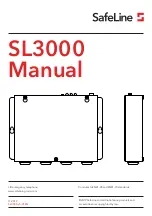
Example: “All, Stations, All Stations, All Stations.
This is <NAME>, <CALL SIGN>, <MMSI ID>,
<POSITION>. Cancel my distress alert of <DATE>,
<TIME>, <NAME>, <CALL SIGN>”
D13230-1
6. Repeat the broadcast described in step 5.
Receiving a distress call
It is expected that only a Coast Radio Station (CRS)
will acknowledge DSC distress calls and will act as the
coordinator for the rescue operation.
When a distress call is received an alarm is sounded at
full volume and the LCD displays information relating
to the distress.
DISTRESS CALL
Show info
Sinking
MMSI 123456789
00:04
Accept
- Ch16 [10]
If the
Auto channel change
function is enabled; 10
seconds after receipt of a distress call the radio will
automatically re-tune to channel 16. Otherwise the user
is prompted to change channel manually.
The details of the distress call are recorded in the
distress log and the envelope icon will flash to let
you know a message has been received. When
connected to a
Raymarine
®
multifunction display
(
MFD
) the position data from the distress call can also
be displayed in the Chart application.
When the received distress call is acknowledged by the
CRS or by another station the radio will resume normal
operation.
Acknowledging a distress call
Distress calls must only be acknowledged if the call
continues without acknowledgement from a CRS, you
are close enough to the distressed vessel to be of
assistance and are prepared to relay the distress to a
CRS by any means possible. Class D DSC radios are
forbidden from automatically acknowledging distress
calls. Acknowledgement must only be made by voice
message on channel 16.
After receiving a distress call that has gone unanswered:
1. Switch to channel 16 to listen for the distress voice
message.
2. Wait for the CRS to acknowledge the call.
3. If the distress call is not acknowledged by another
station then acknowledge the call as follows:
MAYDAY
(MMSI of the vessel in distress)
Name of vessel in distress
<repeated 3 times>
Call sign of the vessel in distress
This is
<MMSI of your vessel>, <name of your
vessel repeated 3 times> <call sign of your vessel>
RECEIVED MAYDAY
4. You MUST then notify the shore authorities by any
means possible to relay the distress call.
Making a routine DSC call
From the
Individual Call
menu:
Menu →DSC Calls
→ Individual Call
.
1. Select
Phonebook
to make a routine call to a
contact saved in your Phonebook, or
2. Select
Recent Calls
to make a routine call to a
contact that you have called recently, or
3. Select
Enter MMSI
to manually enter the MMSI
number of the station you want to contact.
4. Select a contact or enter an MMSI manually and
press the
OK
button.
5. Select the Channel you want to transmit the call on.
If the MMSI is a CSR then the radio will automatically
tune to the correct Channel. The radio will wait for
an acknowledgement to be received.
6. If an acknowledgement is received, press the
OK
button.
7. Press and hold the
PTT
button and speak your
message.
8. Release the
PTT
button when you have completed
your message.
23




































